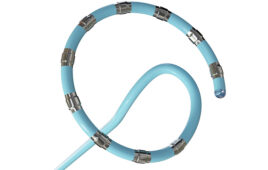
(a) a fully stretchable organic transistor array developed by the Bao group. (b) Fully stretchable organic transistor array on hand shows the skin-like (stretchable and healable) organic transistor developed by the Bao group. [Photo courtesy Zhenan Bao and research team]
The new polymer is stretchable and can heal when it is damaged, according to a Cambridge University Press report. It uses intermolecular hydrogen bonds that can be repeatedly broken and reformed. The polymer could serve as the base for wearable electronics that need to flex, stretch and face mechanical abuse while wearing it.
Zhenan Bao, a chemical engineer at Stanford University, and her team of colleagues from Canada, Japan, South Korea, Taiwan, the U.K. and the U.S. used a molecular design to make these polymers instead, creating a semiconducting polymer that is stretchable but also has a high carrier mobility.
Because of this approach, the tiny nanometer-scale cracks that form in the polymer after extended use can be healed by heating the material with chloroform vapors. The material then almost completely recovers its electronic properties. Healing polymers are a new feature in stretchable electronic devices.
To make this new polymer, researchers started with the semiconducting polymer 3,6-di(thiophen-2-yl)- 2,5-dihydropyrrolo[3,4-c]pyrrole-1,4-dione (or DPP), according to Cambridge University Press During the synthesis of the polymer, they added monomers of 2,6-pyridine dicarboxamide (PDCA).
The DPP’s crystalline structure is broken up by the PDCA, which is what makes it more flexible. The polymer then has semiconducting crystalline DPP units that transport charge. The DPP units are connected by amorphous PDCS regions.
The PDCS unit has two amide groups bound together by weak hydrogen bonds. The amorphous PDCS chains elongate when the material is stretched and the hydrogen bonds break to disperse mechanical energy.
The researchers used their new polymer to make a high-performance field-effect transistor that has a charge mobility of 1.3cm2/V/s. The material of the polymer retains a mobility of over 1cm2/V/s and the transistor’s performance does not change after it is stretched and released 500 times by a quarter of its length.
Thin-film field-effect transistors, which are semiconductor devices that form the basic building blocks of logic circuits, are essential components of the electronics. Traditionally hard and brittle, scientists have begun using rubbery polymers that are blended with semiconducting nanofibers or nanowires to make them suitable to be worn as devices and displays.




